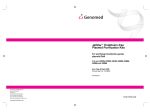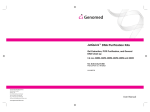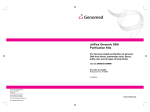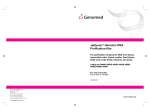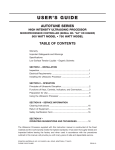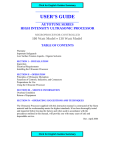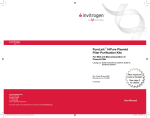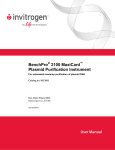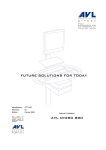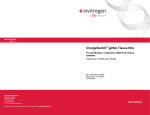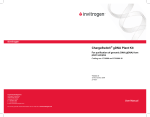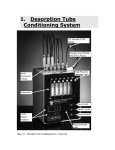Download JETSTAR Plasmid Mini/Midi/Maxi Manual
Transcript
Genomed JetStar™ 2.0 Plasmid Purification Kits A Novel Plasmid Purification System Cat. nos. 200050, 200200, 210025, 210050, 210250, 220010, 220020, and 220100 Rev. Date: 30 March 2010 Manual part no.: 70-15008 MAN0001739 Corporate Headquarters Genomed GmbH Poststr. 22 D-32584 Löhne, Germany Tel:+49-(0)5732-904700 Fax:+49-(0)5732-9047010 [email protected] www.genomed-dna.com User Manual ii Table of Contents Kit Contents and Storage .................................................................................... iv Introduction ........................................................................................ 1 System Summary....................................................................................................1 Experimental Overview ........................................................................................4 Methods............................................................................................... 5 Before Starting ........................................................................................................5 Miniprep Procedure...............................................................................................8 Midiprep Procedure.............................................................................................12 Maxiprep Procedure ............................................................................................17 Estimating DNA Yield.........................................................................................21 Expected Results...................................................................................................22 Appendix ........................................................................................... 23 Procedure for BAC and cosmid DNA ..............................................................23 Troubleshooting ...................................................................................................30 Accessory Products..............................................................................................33 Technical Support ................................................................................................34 Purchaser Notification.........................................................................................35 iii Kit Contents and Storage Types of Kits This manual is supplied with the following products. Product ™ JetStar 2.0 Plasmid Miniprep Kit JetStar™ 2.0 Plasmid Midiprep Kit ™ JetStar 2.0 Plasmid Maxiprep Kit Quantity Cat. no. 50 preps 200050 200 preps 200200 25 preps 210025 50 preps 210050 250 preps 210250 10 preps 220010 20 preps 220020 100 preps 220100 Intended Use For research use only. Not intended for human or animal diagnostic or therapeutic uses. Miniprep Kit Contents The components included in the JetStar™ Plasmid Miniprep Kits are listed below. Store RNase A at 4°C and store all other components at room temperature. Item 200050 200200 50 preps 200 preps Cell Resuspending Buffer (E1) 25 mL 110 mL RNase A (20 mg/mL) 330 μL 650 μL Lysis Buffer (E2) 25 mL 110 mL Precipitation Buffer (E3) 25 mL 110 mL Equilibration Buffer (E4) 110 mL 615 mL Wash Buffer (E5) 270 mL 2 × 615 mL Elution Buffer (E6) 50 mL 200 mL Columns 50 each 200 each Continued on next page iv Kit Contents and Storage, Continued Midiprep and Maxiprep Kit Contents The components included in the JetStar™ 2.0 Plasmid Midiprep and Maxiprep Kits are listed below. Store RNase A at 4°C and store all other components at room temperature. Item 210025 210050 210250 25 preps 50 preps 250 preps Cell Resuspending Buffer (E1) 110 mL 220 mL 2 × 550 mL RNase A (20 mg/mL) 650 μL 1.5 mL 2 × 3 mL Lysis Buffer (E2) 110 mL 220 mL 1,100 mL Precipitation Buffer (E3) 110 mL 220 mL 1,100 mL Equilibration Buffer (E4) 270 mL 615 mL 3,200 mL 2 × 270 mL 2 × 615 mL 2 × 3,200 mL Elution Buffer (E6) 140 mL 300 mL 1,650 mL Columns 25 each 50 each 250 each Wash Buffer (E5) Item Cell Resuspending Buffer (E1) 220010 220020 220100 10 preps 20 preps 100 preps 110 mL 220 mL 2 × 550 mL RNase A (20 mg/mL) 650 μL 1.5 mL 2 × 3 mL Lysis Buffer (E2) 110 mL 220 mL 1,100 mL Precipitation Buffer (E3) 110 mL 220 mL 1,100 mL Equilibration Buffer (E4) 320 mL 615 mL 3,200 mL Wash Buffer (E5) 615 mL 2 × 615 mL 2 × 3,200 mL Elution Buffer (E6) 165 mL 320 mL 1,650 mL Columns 10 each 20 each 100 each Continued on next page v Kit Contents and Storage, Continued Buffer Composition The composition of buffers included in the JetStar™ Kits is listed below. Buffer Composition Cell Resuspending Buffer (E1) 50 mM Tris-HCl, pH 8.0 RNase A 20 mg/mL in 50 mM Tris-HCl, 10 mM EDTA, pH 8.0 Lysis Buffer (E2) 0.2 M NaOH 10 mM EDTA 1% (w/v) SDS Precipitation Buffer (E3) 3.1 M Potassium acetate, pH 5.5 Equilibration Buffer (E4) 0.1 M Sodium acetate, pH 5.0 0.6 M NaCl 0.15% (v/v) Triton® X-100 Wash Buffer (E5) 0.1 M Sodium acetate, pH 5.0 0.8 M NaCl Elution Buffer (E6) 0.1 M Tris-HCl, pH 8.5 1.25 M NaCl vi Introduction System Summary The JetStar™ Technology JetStar™ 2.0 Plasmid Purification Kits contain a unique anion exchange resin, supplied in disposable columns. The Mini, Midi and Maxi columns are used under gravity flow conditions without any further instrumentation. JetStar™ 2.0 Plasmid Kits are the ideal tool to efficiently isolate ultrapure plasmid DNA within 45–60 minutes. Procedure Overview E. coli cells are harvested, resuspended in Cell Resuspending Buffer (E1) with RNase A, and then lysed with Lysis Buffer (E2). Precipitation Buffer (E3) is added to the lysate and the lysate is clarified by centrifugation. The cleared lysate is passed through a pre-packed anion exchange column. The negatively charged phosphates on the backbone of the DNA interact with the positive charges on the surface of the resin. The temperature, salt concentration, and pH of the solutions influence binding. Under moderate salt conditions, plasmid DNA remains bound to the resin while RNA, proteins, carbohydrates and other impurities are washed away with Wash Buffer (E5). The plasmid DNA is eluted under high salt conditions with the Elution Buffer (E6). The eluted DNA is desalted and concentrated with an alcohol precipitation step. The entire protocol can be completed in 1.5–2 hours. Continued on next page 1 System Summary, Continued Advantages Using the JetStar™ 2.0 Plasmid Purification Kits to isolate plasmid DNA provides the following advantages: • Unique anion exchange resin technology to isolate plasmid DNA negates the need for any organic solvents, cesium chloride (CsCl), or vacuum manifolds • High yield of plasmid DNA (see next page) • Purified DNA demonstrates improved performance in downstream applications (see next page) • Purification of all types and sizes of plasmid DNA, including BAC and cosmid DNA (see pages 23–29), as well as ssM13 DNAs, λ-DNA, and plasmid DNA from fungi (protocols available at www.genomed-dna.com) • Minimal contamination with RNA Continued on next page 2 System Summary, Continued System Specifications Specification* Miniprep Midiprep Maxiprep Starting culture volume 1–5 mL 15–25 mL 100 mL Column Binding Capacity** 30 μg 350 μg 850 μg Column Reservoir Capacity 2.5 mL 10 mL 60 mL Elution Volume 0.9 mL 5 mL 15 mL DNA Recovery 85–90% 85–90% 85–90% Expected DNA Yield*** 3–20 μg 45–100 μg 300–500 μg *Specifications and results are based on high copy number plasmids. **Binding capacity depends on plasmid copy number, type and size, and volume of bacterial culture used. ***DNA yield depends on plasmid copy number, plasmid type and size, bacterial strain, and growth conditions. Downstream Applications DNA purified using JetStar™ 2.0 Plasmid Purification Kits is at a purity equivalent to two passes through CsCl gradients and is suitable for downstream applications, including those requiring the highest purity, such as: • Transfection of mammalian cells • Microinjection • Vaccination • Automated and manual DNA sequencing • PCR amplification • In vitro transcription • Cloning 3 Experimental Overview Introduction The flow chart for purifying plasmid DNA using the JetStar™ 2.0 Plasmid Purification Kits is shown below. 2 mL Equilibration Buffer (E4) 10 mL Equilibration Buffer (E4) 30 mL Equilibration Buffer (E4) Harvest Cells Harvest Cells Harvest Cells 0.4 mL Cell Resuspending Buffer (E1) 4 mL Cell Resuspending Buffer (E1) 10 mL Cell Resuspending Buffer (E1) 0.4 mL Lysis Buffer (E2) 4 mL Lysis Buffer (E2) 10 mL Lysis Buffer (E2) 4 mL Precipitation Buffer (E3) 10 mL Precipitation Buffer (E3) Load Column Load Column 2 x 10 mL Wash Buffer (E5) 60 mL Wash Buffer (E5) 0.9 mL Elution Buffer (E6) 5 mL Elution Buffer (E6) 15 mL Elution Buffer (E6) 0.63 mL Isopropanol 3.5 mL Isopropanol 10.5 mL Isopropanol 1 mL 70% Ethanol 3 mL 70% Ethanol 5 mL 70% Ethanol TE Buffer TE Buffer TE Buffer 0.4 mL Precipitation Buffer (E3) Load Column 2 x 2.5 mL Wash Buffer (E5) 4 Methods Before Starting Introduction Review the information in this section before starting. Guidelines are included for growing the overnight cell culture and for determining the appropriate amounts of starting material based on the plasmid copy number used. Some buffers in the JetStar™ 2.0 Plasmid Purification Kits contain hazardous chemicals. Always wear a laboratory coat, disposable gloves, and eye protection when handling the buffers. MEND ION AT RECOM Plasmid Yields All types and sizes of plasmid DNA can be prepared, but yields depend on the type of plasmid, copy number (low/medium/high), the bacterial strain, and the volume of bacterial culture used. JetStar™ 2.0 Plasmid Purification Kits are preferentially designed to extract and purify high copy plasmid DNA from E. coli cultures. Low copy plasmids can be prepared as well, but larger culture volumes will be necessary. Although the JetStar™ system is compatible with other growth media, including rich media, we strongly recommend growing transformed E. coli cells overnight in buffered LB (Luria-Bertani) media for optimal results. The cell density should be approximately 1 × 109 cells per mL medium (1–1.5 A600 units/mL). Continued on next page 5 Before Starting, Continued Plasmid Type and Copy Number Use a high copy number plasmid to obtain a good yield of plasmid DNA. If you are using a low copy number plasmid, use a higher volume of cell culture, as directed in the protocol. High copy number plasmids typically yield >3–5 μg DNA/mL LB culture grown overnight; whereas low copy number plasmids typically yield 0.2–1 μg DNA/mL LB culture grown overnight. The table below lists the starting culture volumes recommended for Miniprep, Midiprep, and Maxiprep plasmid DNA purification based on the plasmid copy number. Plasmid Copy Number Specific Protocols Miniprep Midiprep Maxiprep High copy number plasmid 1–5 mL 15–25 mL 100 mL Low copy number plasmid 10–15 mL 25–100 mL 250–500 mL The JetStar™ 2.0 Plasmid Purification Kits may be used to purify all types and sizes of plasmid DNA, including BAC and cosmid DNA. Specific protocols for plasmid DNA purification using the various kits are described in this manual (see table below for page references). Additional procedures for purifying λ-DNA, ssM13 DNA, and plasmid DNA from fungi are available at www.genomed-dna.com or by contacting Technical Support (see page 34). Protocol Page no. Purifying plasmid DNA using: Miniprep kit 8 Midiprep kit 12 Maxiprep kit 17 Procedure for BAC and cosmid DNA 23 Continued on next page 6 MEND ION AT RECOM Before Starting, Continued Follow the recommendations below to obtain the best results: • Maintain a sterile environment when handling DNA to avoid any contamination from DNases. • Ensure that no DNase is introduced into the sterile buffers supplied with the kit. • Sterilize all equipment coming in contact with DNA, including pipette tips and tubes. • Perform the recommended wash steps during purification to obtain the best results. • Use TE Buffer or 10 mM Tris-HCl, pH 8.5 to resuspend the DNA pellet. Purification Rack The JetRack is designed specifically for use with the JetStar™ 2.0 Plasmid DNA Midiprep and Maxiprep Kits (see page 33 for ordering information). The JetRack consists of a Column Holder Rack (for processing 8 midiprep and 4 maxiprep columns simultaneously), a Collection Tube Rack (capable of accommodating various types and sizes of recovery tubes), and a Waste Container for collecting waste. Preparing Buffers Cell Resuspending Buffer (E1) Add RNase A to the Cell Resuspending Buffer (E1) according to the note with the RNase A tube. Mix well. The final RNase A concentration is 100 μg/mL. Mark the bottle label to indicate that RNase A is added. Store the buffer with RNase A at 4°C. Lysis Buffer (E2) Check the Lysis Buffer (E2) for precipitates. If present, warm the solution briefly at 37°C to dissolve the precipitate. 7 Miniprep Procedure Introduction Up to 20 μg of high quality plasmid DNA may be purified with the JetStar™ 2.0 Plasmid Miniprep Kit in ~1 hour using 1–5 mL overnight E. coli cultures, when using high copy number plasmids. Before Starting Before beginning, verify that RNase A is added to the Cell Resuspending Buffer (E1) and that no precipitate has formed in the Lysis Buffer (E2). Materials Supplied by the User • Overnight culture of transformed E. coli cells • Tubes or buckets of appropriate size for harvesting cells • Centrifuge and rotor appropriate for harvesting cells • Isopropanol • 70% ethanol • Sterile microcentrifuge tubes • Microcentrifuge capable of centrifuging at >12,000 × g • Cell Resuspending Buffer (E1) with RNase A (page 7) • Lysis Buffer (E2) • Precipitation Buffer (E3) • Equilibration Buffer (E4) • Wash Buffer (E5) • Elution Buffer (E6) • JetStar™ Mini Columns Components Supplied with the Kit Continued on next page 8 Miniprep Procedure, Continued Equilibrating the Column Apply 2 mL Equilibration Buffer (E4) to the JetStar™ Mini column. Allow the solution in the column to drain by gravity flow. Equilibration takes about 5–10 minutes, but does not influence the speed of the protocol; therefore, proceed to Step 1 (below) during equilibration. Overnight Culture • For high copy number plasmids, use 1–5 mL of an overnight LB culture per sample in a microcentrifuge tube. Note: When using 2–3 mL of culture, pellet 1–1.5 mL culture twice in the same microcentrifuge tube. If you are using >5 mL of culture volume of high copy plasmids, add twice the amount of Cell Resuspending Buffer (E1) with RNase A, Lysis Buffer (E2), and Precipitation Buffer (E3) as directed in Steps 2, 3, and 4, below and next page, for best results. Preparing Cell Lysate • For low copy number plasmids, use 10–15 mL of an overnight LB culture per sample in a 15-mL disposable tube. 1. Harvest the cells by centrifuging the overnight LB-culture at 4,000 × g for 5–10 minutes. Remove all medium. 2. Add 0.4 mL Cell Resuspending Buffer (E1) with RNase A to the pellet and resuspend cells until homogeneous. Note: If overnight culture volume is >5 mL, use 0.8 mL Buffer E1. If cells were resuspended in a 15-mL disposable tube, transfer the cells to a microcentrifuge tube. Continued on next page 9 Miniprep Procedure, Continued Preparing Cell Lysate, Continued 3. Add 0.4 mL Lysis Buffer (E2). Mix gently by inverting the capped tube until a homogenous mixture is obtained. Do not vortex. Incubate at room temperature for 5 minutes. Note: Do not allow lysis to proceed for more than 5 minutes. If overnight culture volume is >5 mL, use 0.8 mL Buffer E2. 4. Add 0.4 mL Precipitation Buffer (E3) and mix immediately by inverting the tube until the mixture is homogeneous. The viscous matter present after cell lysis (Step 3) should not remain. Do not vortex. Note: When many samples are prepared in parallel, mix each sample immediately after adding Buffer E3. If overnight culture volume is >5 mL, use 0.8 mL Buffer E3. 5. Centrifuge the lysate at >12,000 × g for 10 minutes at room temperature. Note: If the pellet does not adhere to the bottom of the tube, incubate the tube at room temperature for 5 minutes to allow the separation of lysate and pellet. Pipette the clear lysate into another sterile tube and centrifuge at >12,000 × g for 5 minutes at room temperature to remove any remaining cellular debris. Binding and Washing DNA 6. Proceed to Binding and Washing DNA (below). 1. Load the supernatant from Step 5 (above) onto the equilibrated column with a pipette. Allow the solution in the column to drain by gravity flow. 2. Wash the column twice with 2.5 mL Wash Buffer (E5). Allow the solution in the column to drain by gravity flow after each wash. Discard the flow-through. 3. Proceed to Eluting and Precipitating DNA, page 11. Continued on next page 10 Miniprep Procedure, Continued Eluting and Precipitating DNA 1. Place a sterile microcentrifuge tube under the column. 2. Add 0.9 mL Elution Buffer (E6) to the column to elute the DNA. Allow the solution to drain by gravity flow. Do not force out any remaining solution. The elution tube contains the purified DNA. Discard the column. 3. Add 0.63 mL isopropanol to the elution tube. Mix well. 4. Centrifuge the elution tube at >12,000 × g for 30 minutes at 4°C. Carefully remove and discard the supernatant. 5. Wash the DNA pellet in 1 mL 70% ethanol. 6. Centrifuge at >12,000 × g for 5 minutes at 4°C. Carefully remove and discard the supernatant. 7. Air-dry the pellet for 10 minutes. Note: Be careful when drying the DNA pellet under vacuum in a speed-vac or in a vacuum chamber using an oil pump or a water jet filter pump. If the pellet is overdried, the DNA will not redissolve completely. 8. Resuspend the DNA pellet in a suitable volume of buffer (i.e., 10 mM Tris-HCl, pH 8.0, TE Buffer, or water). Note: Occasionally, insoluble particles may be present. These particles do not influence the quality of the DNA and can be easily removed. To remove insoluble particles, centrifuge the DNA solution at high speed for 1 minute at room temperature. Transfer the supernatant (DNA sample) into a fresh tube. Storing DNA To avoid repeated freezing and thawing of DNA, store the purified DNA at 4°C for immediate use or aliquot the DNA and store at −20°C for long-term storage. 11 Midiprep Procedure Introduction Up to 100 μg of high-quality plasmid DNA may be purified with the JetStar™ 2.0 Plasmid Midiprep Kit in ~2 hours from 15–25 mL overnight E. coli cultures, when using high copy number plasmids. Before Starting Before beginning, verify that RNase A is added to the Cell Resuspending Buffer (E1) and that no precipitate has formed in the Lysis Buffer (E2), page 7. Materials Supplied by the User • Overnight culture of transformed E. coli cells • Tubes or buckets of appropriate size for harvesting cells • Centrifuge and rotor appropriate for harvesting cells • Isopropanol • 70% ethanol • Sterile microcentrifuge tubes • JetRack (see page 33). • Appropriate 15 mL centrifuge tubes capable of withstanding centrifugation forces > 12,000 × g • Centrifuge capable of centrifuging at >12,000 × g at 4°C • Optional: PureLink™ HiPure Precipitator Module (page 33). • Cell Resuspending Buffer (E1) with RNase A (page 7) • Lysis Buffer (E2) • Precipitation Buffer (E3) • Equilibration Buffer (E4) • Wash Buffer (E5) • Elution Buffer (E6) • JetStar™ Midi Columns Components Supplied with the Kit Continued on next page 12 Midiprep Procedure, Continued Equilibrating the Column Place the JetStar™ Midi Column on the JetRack (see the manual supplied with the rack for more details). Apply 10 mL Equilibration Buffer (E4) to the column. Allow the solution in the column to drain by gravity flow. Equilibration takes 10–15 minutes, but does not influence the speed of the protocol; therefore, proceed to Step 1 (below) during equilibration. Overnight Culture • For high copy number plasmids, use 15–25 mL of an overnight LB culture per sample in a 50-mL disposable tube. • For low copy number plasmids, use 25–100 mL of an overnight LB culture per sample. Note: If you are using >25 mL of culture volume of high copy plasmids, add twice the amount of Cell Resuspending Buffer (E1) with RNase A, Lysis Buffer (E2), and Precipitation Buffer (E3) as directed in Steps 2, 3, and 4, below and next page, for best results. Preparing Cell Lysate 1. Harvest the cells by centrifuging the overnight LB-culture at 4,000 × g for 10 minutes in a bucket. Remove all medium. 2. Add 4 mL Cell Resuspending Buffer (E1) with RNase A to the cell pellet and resuspend the cells until homogeneous. Transfer the cell suspension to a 15 mL centrifuge tube. Note: If overnight culture volume is >25 mL, use 8 mL Buffer E1. Continued on next page 13 Midiprep Procedure, Continued Preparing Cell Lysate, Continued 3. Add 4 mL Lysis Buffer (E2). Mix gently by inverting the capped tube until a homogenous mixture is obtained. Do not vortex. Incubate at room temperature for 5 minutes. Note: Do not allow lysis to proceed for more than 5 minutes. If overnight culture volume is >25 mL, use 8 mL Buffer E2. 4. Add 4 mL Precipitation Buffer (E3) and mix immediately by inverting the capped tube until the mixture is homogeneous. The viscous matter present after cell lysis (Step 3) should not remain. Do not vortex. Note: When many samples are prepared in parallel, mix each sample immediately after adding Buffer E3. If overnight culture volume is >25 mL, use 8 mL Buffer E3. 5. Centrifuge the mixture at >12,000 × g for 10 minutes at room temperature. Note: If the pellet does not adhere to the bottom of the tube, incubate the tube at room temperature for 5 minutes to allow the separation of lysate and pellet. Pipette the clear lysate into another sterile tube and centrifuge at >12,000 × g for 5 minutes at room temperature to remove any remaining cellular debris. Binding and Washing DNA 6. Proceed to Binding and Washing DNA, below. 1. Load the supernatant from Step 5 (above) onto the equilibrated column with a pipette. Allow the solution in the column to drain by gravity flow. 2. Wash the column twice with 10 mL Wash Buffer (E5). Allow the solution in the column to drain by gravity flow after each wash. Discard the flow-through. 3. Proceed to Eluting and Precipitating DNA, next page. Continued on next page 14 Midiprep Procedure, Continued For DNA precipitation, you can use the PureLink™ HiPure Precipitator Module (page 33) which allows DNA precipitation within 10 minutes without any centrifugation steps; or you can follow the protocol below to perform traditional DNA precipitation using centrifugation. Eluting and Precipitating DNA 1. Place a sterile microcentrifuge tube (elution tube) under the column. 2. Add 5 mL Elution Buffer (E6) to the column to elute the DNA. Allow the solution to drain by gravity flow. Do not force out any remaining solution. The elution tube contains the purified DNA. Discard the column. 3. Add 3.5 mL isopropanol to the elution tube. Mix well. Note: Proceed to the protocol described in the PureLink™ HiPure Precipitator manual after this step if you are using the precipitator module. 4. Centrifuge the elution tube at >12,000 × g for 30 minutes at 4°C. Carefully remove and discard the supernatant. 5. Wash the DNA pellet in 3 mL 70% ethanol. 6. Centrifuge at >12,000 × g for 5 minutes at 4°C. Carefully remove and discard the supernatant. 7. Air-dry the pellet for 10 minutes. Note: Be careful when drying the DNA pellet under vacuum in a speed-vac or in a vacuum chamber using an oil pump or a water jet filter pump. If the pellet is overdried, the DNA will not redissolve completely. Continued on next page 15 Midiprep Procedure, Continued Eluting and Precipitating DNA, Continued 8. Storing DNA To avoid repeated freezing and thawing of DNA, store the purified DNA at 4°C for immediate use or aliquot the DNA and store at −20°C for long-term storage. 16 Resuspend the DNA pellet in a suitable volume of buffer (i.e., 10 mM Tris-HCl, pH 8.0, TE Buffer, or water). Note: Occasionally, insoluble particles may be present. These particles do not influence the quality of the DNA and can be easily removed. To remove insoluble particles, centrifuge the DNA solution at high speed for 1 minute at room temperature. Transfer the supernatant (DNA sample) into a fresh tube. Maxiprep Procedure Introduction Up to 500 μg of high-quality plasmid DNA may be purified with the JetStar™ Plasmid Maxiprep Kit in ~2 hours from 100 mL overnight E. coli cultures, when using high copy number plasmids. Before Starting Before beginning, verify that RNase A is added to the Cell Resuspending Buffer (E1) and that no precipitate has formed in the Lysis Buffer (E2), see page 7. Materials Supplied by the User • Overnight culture of transformed E. coli cells • Isopropanol • 70% ethanol • Sterile microcentrifuge tubes • JetRack (page 33). • Appropriate 50 mL centrifuge tube capable of withstanding centrifugation forces > 12,000 × g • Centrifuge capable of centrifuging at >12,000 × g at 4°C • Optional: PureLink™ HiPure Precipitator Module (page 33) • Cell Resuspending Buffer (E1) with RNase A (page 7) • Lysis Buffer (E2) • Precipitation Buffer (E3) • Equilibration Buffer (E4) • Wash Buffer (E5) • Elution Buffer (E6) • JetStar™ Maxi Columns Components Supplied with the Kit Continued on next page 17 Maxiprep Procedure, Continued Equilibrating the Column Place the JetStar™ Maxi Column on the JetRack (see the manual supplied with the rack for more details). Apply 30 mL Equilibration Buffer (E4) to the column. Allow the solution in the column to drain by gravity flow. Equilibration takes about 10–15 minutes, but does not influence the speed of the protocol; therefore, proceed to Step 1 (below) during equilibration. Overnight Culture • For high copy number plasmids, use 100 mL of an overnight LB culture per sample. • For low copy number plasmids, use 250–500 mL of an overnight LB culture per sample. Note: For culture volumes >200 mL, add twice the amount of Cell Resuspending Buffer (E1) with RNase A, Lysis Buffer (E2), and Precipitation Buffer (E3) as directed in Steps 2, 3, and 4, below and next page. Preparing Cell Lysate 1. Harvest the cells by centrifuging the overnight LB-culture at 4,000 × g for 10 minutes in a bucket. Remove all medium. 2. Add 10 mL Cell Resuspending Buffer (E1) with RNase A to the pellet and resuspend the cells until homogeneous. Transfer cell suspension to a 50-mL centrifuge tube. Note: If overnight culture volume is >200 mL, use 20 mL Buffer E1. 3. Add 10 mL Lysis Buffer (E2). Mix gently by inverting the capped tube until a homogenous mixture is obtained. Do not vortex. Incubate at room temperature for 5 minutes. Note: Do not allow lysis to proceed for more than 5 minutes. If overnight culture volume is >200 mL, use 20 mL Buffer E2. Continued on next page 18 Maxiprep Procedure, Continued Preparing Cell Lysate, Continued 4. Add 10 mL Precipitation Buffer (E3) and mix immediately by inverting the capped tube until the mixture is homogeneous. The viscous matter present after cell lysis (Step 3) should not remain. Do not vortex. Note: When many samples are prepared in parallel, each sample should be mixed immediately after adding Buffer E3. If overnight culture volume is >200 mL, use 20 mL Buffer E3. 5. Centrifuge the mixture at >12,000 × g for 10 minutes at room temperature. Note: If the pellet does not adhere to the bottom of the tube, incubate the tube at room temperature for 5 minutes to allow the separation of lysate and pellet. Pipette the clear lysate into another sterile tube and centrifuge at >12,000 × g for 5 minutes at room temperature to remove any remaining cellular debris. Binding and Washing DNA 6. Proceed to Binding and Washing DNA, below. 1. Load the supernatant from Step 5 (above) onto the equilibrated column with a pipette. Allow the solution in the column to drain by gravity flow. 2. Wash the column with 60 mL Wash Buffer (E5). Allow the solution in the column to drain by gravity flow. Discard the flow-through. 3. Proceed to Eluting and Precipitating DNA (next page). For DNA precipitation, you can use the PureLink™ HiPure Precipitator Module (page 33) which allows DNA precipitation within 10 minutes without any centrifugation steps; or you can follow the protocol on the next page to perform traditional DNA precipitation using centrifugation. Continued on next page 19 Maxiprep Procedure, Continued Eluting and Precipitating DNA 1. Place a sterile 50-mL centrifuge tube (elution tube) under the column. 2. Add 15 mL Elution Buffer (E6) to the column. Allow the solution to drain by gravity flow. Do not force out any remaining solution. Discard the column. The elution tube contains the purified DNA. 3. Add 10.5 mL isopropanol to the elution tube. Mix well. Note: Proceed to the protocol described in the PureLink™ HiPure Precipitator manual after this step if you are using the precipitator. 4. Centrifuge at >12,000 × g for 30 minutes at 4°C. Carefully remove and discard the supernatant. 5. Wash the DNA pellet in 5 mL 70% ethanol. 6. Centrifuge the elution tube at >12,000 × g for 5 minutes at 4°C. Carefully remove and discard the supernatant. 7. Air-dry the pellet for 10 minutes. Note: Be careful when drying the DNA pellet under vacuum in a speed-vac or in a vacuum chamber using an oil pump or a water jet filter pump. If the pellet is overdried, the DNA will not redissolve completely. 8. Resuspend the DNA pellet in a suitable volume of buffer (i.e. 10 mM Tris-HCl, pH 8.0, TE Buffer or water). Note: Occasionally, insoluble particles may be present. These particles do not influence the quality of the DNA and can be easily removed. To remove insoluble particles, centrifuge the DNA solution at high speed for 1 minute at room temperature. Transfer the supernatant (DNA sample) into a fresh tube. Storing DNA 20 To avoid repeated freezing and thawing of DNA, store the purified DNA at 4°C for immediate use or aliquot the DNA and store at −20°C for long-term storage. Estimating DNA Yield DNA Yield Perform DNA quantitation using UV absorbance at 260 nm or Quant-iT™ DNA Assay Kits (see page 33 for ordering information). UV Absorbance 1. Prepare a dilution of the DNA solution in 10 mM Tris-HCl, pH 7.5. Mix well. Measure the absorbance of the dilution at 260 nm (A260) in a spectrophotometer (using a cuvette with an optical path length of 1 cm) blanked against 10 mM Tris-HCl, pH 7.5. 2. Calculate the concentration of DNA using the formula: DNA (μg/mL) = A260 × 50 × dilution factor For DNA, A260 = 1 for a 50 μg/mL solution measured in a cuvette with an optical path length of 1 cm. Quant-iT™ DNA Assay Kits The Quant-iT™ DNA Assay Kits (page 33) provide a rapid, sensitive, and specific method for dsDNA quantitation with minimal interference from RNA, protein, ssDNA (primers), or other common contaminants that affect UV absorbance. The kit contains a state-of-the-art quantitation reagent, prediluted standards for standard curve, and a pre-made buffer. The assay is designed for reading in standard fluorescent readers/fluorometer or Qubit® Fluorometer. 21 Expected Results Summary of Expected Results The summary of results using the JetStar™ Plasmid DNA Purification Kits is listed in the table below. Note: DNA yield depends on plasmid copy number and type, bacterial strain, and growth conditions. Results for: Miniprep Midiprep Maxiprep Processing Time ~1 hour ~2 hours ~2 hours Plasmid DNA Yield ≤20 μg 100 μg 500 μg Endotoxin <0.1 EU/μg <0.1 EU/μg <0.1 EU/μg Automated Sequencing Successful Successful Successful Restriction Enzyme Digestion Successful Successful Successful 22 Appendix Procedure for BAC and cosmid DNA BAC and cosmid DNA JetStar™ 2.0 Plasmid Purification Kits allow you to purify high quality BAC (bacterial artificial chromosome) and cosmid DNA as well as PAC, YAC, or P1 constructs from E. coli cultures (see pages 23–29). To purify λ-DNA, ssM13 DNA, and plasmid DNA from fungi using JetStar™ Plasmid Purification Kits, download protocols at www.genomeddna.com or contact Technical Support (see page 34). Since BAC, cosmid, PAC, YAC, and P1 DNA species behave like very low copy plasmids (in most cases present with 1 copy per cell), it is necessary to work with large volumes of culture (up to 500 mL) to obtain a reasonable DNA yield. Therefore, we recommend using the JetStar™ 2.0 Plasmid Maxiprep Kits. To scale down the procedure to the Mini- or Midi-scale, use the amounts of bacterial culture mentioned in the protocol below. Materials Supplied by the User • Overnight culture of transformed E. coli cells • Modified Wash Buffer (E5-850, pH 4.0), see page 26 • Isopropanol • 70% ethanol • Sterile microcentrifuge tubes • JetRack (page 33). • Tubes or buckets of appropriate size for harvesting cells • Centrifuge and rotor appropriate for harvesting cells • Appropriate 50 mL centrifuge tube capable of withstanding centrifugation forces > 12,000 × g • Centrifuge capable of centrifuging at >12,000 × g at 4°C • Optional: PureLink™ HiPure Precipitator Module (page 33) Continued on next page 23 Procedure for BAC and cosmid DNA, Continued Components Supplied with the Kit Media Requirements • Cell Resuspending Buffer (E1) with RNase A (page 25) • Lysis Buffer (E2) • Precipitation Buffer (E3) • Equilibration Buffer (E4) • Elution Buffer (E6) • JetStar™ Maxi Columns In addition to LB broth, JetStar™ Plasmid Purification Kits are compatible with other media that are commonly used for the propagation of E. coli (i.e., Terrific Broth, or 2X YT). MEND ION AT RECOM Due to increased volumes used in this protocol, the amount of buffers provided in the JetStar™ Plasmid Purification Kits may not be sufficient to utilize all of the columns provided. For your convenience, buffers may be purchased separately, see page 33. Because large DNA species are "sticky", they will spread over the wall of the centrifuge tube if a fixed angle rotor is used. Therefore, a swing-out-rotor (i.e. HB-4 or HB-6 for Sorvall centrifuges) is recommended. If a swing-out-rotor is not available, siliconize the centrifuge tubes (i.e., Corex) with dimethyldichlorosilane. Continued on next page 24 Procedure for BAC and cosmid DNA, Continued Contaminating RNA Using large amounts of bacterial culture increases the likelihood of residual RNA in the eluate. Follow the hints and suggestions below for mitigating RNA contamination. • • Normally, 100 μg/mL RNase A is sufficient to eliminate RNA (see Step 2, Preparing Cell Lysate, page 27). However, for the highest amounts of bacterial culture suggested (i.e., 500 mL for a Maxiprep), increase the amount of RNase A in Buffer E1 to 400 μg/mL and add 100 U/mL of RNase T1. The combined activities of RNase A and T1 result in better digestion efficiency. The higher salt concentration (850 mM NaCl instead of 800 mM) and the lower pH value (4.0) in the modified Wash Buffer (E5-850, pH 4.0), lead to a more efficient removal of residual RNA without affecting the DNA yield significantly (see page 26 for recipe). Elution Buffer Because of the large size of the constructs, it is useful to prewarm Buffer E6 to 50°C for elution. Before Starting • Reconstitute Cell Resuspending Buffer (E1) with the RNase A stock solution (20 mg/mL, provided with the kit). See Contaminating RNA, above. • Inoculate a bacterial culture with the appropriate antibiotic and grow the bacteria for 14–16 h. • Use the following amounts of bacterial culture: Prep size Culture volume Mini 10–20 mL Midi Up to 100 mL Maxi 300–500 mL Continued on next page 25 Procedure for BAC and cosmid DNA, Continued Recipe for Modified Wash Buffer: (E5-850, pH 4.0) Modified Wash Buffer (E5-850, pH 4.0) 100 mM sodium acetate, pH 4.0 850 mM NaCl 1. Mix the following components to prepare 1 L Buffer E5-850, pH 4.0: Sodium acetate Glacial acetic acid NaCl Ultra pure water Equilibrating the Column 8.2 g 15 g 49.67 g 800 mL 2. Mix well and adjust with water to bring the final volume to 1 liter. Check the pH. The final pH may differ slightly (± 0.1) depending on the pH meter used and such slight deviations can be tolerated. Do not adjust the pH value using salt or acid. 3. Store the buffer at room temperature. Apply Equilibration Buffer (E4) to the column. Allow the solution in the column to drain by gravity flow. Reagent Miniprep Midiprep Maxiprep Equilibration Buffer (E4) 2 mL 10 mL 30 mL Continued on next page 26 Procedure for BAC and cosmid DNA, Continued Preparing Cell Lysate 1. Harvest the cells by centrifuging the overnight culture at 4,000 × g for 10 minutes in a bucket. Remove all medium. 2. Add Cell Resuspending Buffer (E1) containing RNase A to the pellet and resuspend the cells until homogeneous (no cell clumps should be visible). Transfer cell suspension to a centrifuge tube. Reagent Miniprep Midiprep Maxiprep Cell Resuspending Buffer (E1) 1 mL 8 mL 20 mL 3. Add Lysis Buffer (E2). Mix gently by inverting the capped tube until a homogenous mixture is obtained. Do not vortex. Incubate at room temperature for 5 minutes. Reagent Miniprep Midiprep Maxiprep Lysis Buffer (E2) 1 mL 8 mL 20 mL 4. Neutralize with Precipitation Buffer (E3). Mix gently but thoroughly until a homogeneous mixture is obtained. Do not vortex. Reagent Miniprep Midiprep Maxiprep Precipitation Buffer (E3) 1 mL 8 mL 20 mL 5. Centrifuge the mixture at >12,000 × g at room temperature for 10 minutes. Transfer the supernatant into a fresh tube. 6. Proceed to Binding and Washing DNA, next page. Continued on next page 27 Procedure for BAC and cosmid DNA, Continued Binding and Washing DNA Eluting and Precipitating DNA 1. Load the supernatant from Step 5 (page 27) onto the equilibrated column. Allow the solution in the column to drain by gravity flow. Do not force out remaining buffer. 2. Wash the JetStar™ Column with the following volumes of Modified Wash Buffer (E5-850, pH 4.0): Reagent Miniprep Midiprep Maxiprep Modified Wash Buffer (E5-850, pH 4.0) 2 × 3 mL 2 × 10 mL 2 × 30 mL 3. Proceed to Eluting and Precipitating DNA, below. 1. Place a sterile centrifuge tube under the column. 2. Add Elution Buffer (E6) warmed to 50°C onto the column to elute DNA. Allow the solution to drain by gravity flow. Do not force out any remaining solution. The elution tube contains the purified DNA. 3. 4. Reagent Miniprep Midiprep Maxiprep Elution Buffer (E6) 0.9 mL 5 mL 15 mL Add 0.7 volumes of isopropanol to the elution tube. Reagent Miniprep Midiprep Maxiprep Isopropanol 0.63 mL 3.5 mL 10.5 mL Centrifuge the mixture at >12,000 × g for 30 minutes at 4°C. Carefully remove and discard the supernatant. Continued on next page 28 Procedure for BAC and cosmid DNA, Continued Eluting and Precipitating DNA, Continued 5. 6. Storing DNA Wash the DNA pellet in 70% ethanol. Reagent Miniprep Midiprep Maxiprep Volume of 70% ethanol 1 mL 3 mL 5 mL Centrifuge at >12,000 × g for 5 minutes at 4°C. Carefully remove and discard the supernatant. 7. Air-dry the pellet for 5–10 minutes. 8. Resuspend the DNA pellet in 10 mM Tris-HCl (pH 8.5), TE Buffer, or water. Reagent Miniprep Midiprep Maxiprep TE Buffer 50 μL 200 μL 500 μL To avoid repeated freezing and thawing of DNA, store the purified DNA at 4°C for immediate use or aliquot the DNA and store at −20°C for long-term storage. 29 Troubleshooting Introduction Review the information below to troubleshoot your experiments with JetStar™ Plasmid Purification Kits. A Diagnosis Protocol is useful for determining the cause of low or negative yields. By precipitating DNA after key steps of the purification protocol you may track DNA loss. The Diagnosis Protocol can be downloaded at www.genomed-dna.com or by contacting Technical Support (see page 34). Problem Pipetting lysate Low plasmid DNA yield Cause Solution Pellet is viscous and does not adhere to tube After centrifuging the lysate, allow the tube to sit for 5 minutes. Transfer the clear lysate to a fresh tube and centrifuge again to remove any remaining debris. Using a high volume of culture Use the recommended culture volumes. Temperature of Buffers E1–E6 too low Store Buffers E1–E6 at room temperature. Lysate centrifuged at 4°C Use the rotor and centrifuge at room temperature. Alternatively, if the lysate is centrifuged at 4°C, warm the cleared lysate to room temperature (18°C to 25°C) before loading onto the JetStar™ Column. Continued on next page 30 Troubleshooting, Continued Problem Low plasmid DNA yield Cause Low copy number plasmid. Plasmid quantity in E. coli cells is dependent on the individual hostplasmid system Solution Increase the volume of starting culture. Carefully remove all medium before resuspending cells. Doubling the volumes of the Cell Resuspending Buffer (E1), Lysis Buffer (E2), and Precipitation Buffer (E3) may increase plasmid yield and quality. Plasmid DNA pellet over-dried Air dry the DNA pellet. Drying the DNA pellet under vacuum in a speed-vac or in a vacuum chamber using an oil pump or a water jet filter pump may cause overdrying of the DNA pellet. Slow column flow Column clogged Pipette the lysate supernatant onto the column. Do not pour the lysate onto the column, as some of the precipitate could enter the column. Genomic DNA contamination Genomic DNA sheared during handling Gently invert tubes to mix after adding buffers. Do not vortex during Steps 3 and 4 of Preparing Cell Lysate as it can shear genomic DNA. Additional plasmid forms present Plasmid DNA permanently denatured, evident as a band migrating faster than supercoiled DNA on an agarose gel Incubate the lysate, after the addition of Buffer E2 in Step 3 of Preparing Cell Lysate, at room temperature for no longer than 5 minutes. Continued on next page 31 Troubleshooting, Continued Problem Cause Solution Insoluble particles If a few particles are visible with the redissolved plasmid DNA, the quality of the DNA is not compromised RNA contamination Lysate at improper pH Avoid changes in conditions and or salt concentration volumes of Buffers E1–E6. 32 Centrifuge the plasmid DNA solution for 1 minute and transfer the supernatant into a new tube. Lysate left on column too long Once the lysate is loaded onto the column, avoid delays in processing. Lysate droplets remaining on walls of column at elution Wash away droplets of lysate from the walls of the column with Wash Buffer (E5). Allow Buffer E5 to run completely through the column before the second round of E5 or the Elution Buffer (E6) is applied. Lysate at improper temperature Make sure that the lysate is not warmed above room temperature during centrifugation. RNase A digestion incomplete Make sure that RNase A is added to Cell Resuspending Buffer (E1) and that it has been stored at 4°C for no longer than 6 months. Use recommended volume of Buffer E1. Host strain extremely rich of RNA Use Modified Wash Buffer (E5-850, pH 4.0) instead of standard Wash Buffer (page 26). Accessory Products Additional Products The table below lists additional products available from Genomed or Invitrogen that may be used with the JetStar™ Plasmid DNA Purification Kits. For more information about these products, visit www.genomed-dna.com or www.invitrogen.com. Products below are available from Genomed. See www.genomed-dna.com Product Amount Cat. no. Cell Resuspending Buffer (E1) 500 mL E1-500 Lysis Buffer (E2) 500 mL E2-500 Precipitation Buffer (E3) 500 mL E3-500 Equilibration Buffer (E4) 1,000 mL E4-1,000 Wash Buffer (E5) 1,000 mL E5-1,000 Elution Buffer (E6) 1,000 mL E6-1,000 Ribonuclease A 50 mg GN-RN-50 100 mg GN-RN-100 JetRack 1 unit 210 001 Products below are available from Invitrogen. See www.invitrogen.com Quant-iT™ DNA Assay Kit, High Sensitivity ™ Quant-iT DNA Assay Kit, Broad-Range 1000 assays Q33120 1000 assays Q33130 ® Luria Broth Base (Miller’s LB Broth Base) , powder 500 g 12795-027 2.5 kg 12795-084 Ampicillin Sodium Salt, irradiated 200 mg 11593-027 Carbenicillin, Disodium Salt 5g 10177-012 10 preps K2100-21 25 preps K2100-22 ™ PureLink HiPure Precipitator Module 33 Technical Support World Wide Web Contact Us Visit the website at www.genomed-dna.com for: • Technical resources, including manuals, MSDSs, FAQs • Complete technical support contact information • Access to the Online Catalog • Additional product information and special offers For more information or technical assistance, call, write, fax, or email. Additional international offices are listed on www.genomed-dna.com. GENOMED GmbH Poststr. 22 D-32584 Löhne, Germany Tel: +49-(0)5732-904700 Fax: +49-(0)5732-9047010 E-mail: [email protected] 34 Purchaser Notification Limited Warranty GENOMED (a part of Life Technologies Corporation) is committed to providing our customers with high-quality goods and services. Our goal is to ensure that every customer is 100% satisfied with our products and our service. If you should have any questions or concerns about an Invitrogen product or service, contact our Technical Support Representatives. All GENOMED products are warranted to perform according to specifications stated on the certificate of analysis. The Company will replace, free of charge, any product that does not meet those specifications. This warranty limits the Company’s liability to only the price of the product. No warranty is granted for products beyond their listed expiration date. No warranty is applicable unless all product components are stored in accordance with instructions. The Company reserves the right to select the method(s) used to analyze a product unless the Company agrees to a specified method in writing prior to acceptance of the order. GENOMED makes every effort to ensure the accuracy of its publications, but realizes that the occasional typographical or other error is inevitable. Therefore the Company makes no warranty of any kind regarding the contents of any publications or documentation. If you discover an error in any of our publications, report it to our Technical Support Representatives. Life Technologies Corporation shall have no responsibility or liability for any special, incidental, indirect or consequential loss or damage whatsoever. The above limited warranty is sole and exclusive. No other warranty is made, whether expressed or implied, including any warranty of merchantability or fitness for a particular purpose. Continued on next page 35 Purchaser Notification, Continued Limited Use Label License No. 5: Invitrogen Technology The purchase of this product conveys to the buyer the nontransferable right to use the purchased amount of the product and components of the product in research conducted by the buyer (whether the buyer is an academic or for-profit entity). The buyer cannot sell or otherwise transfer (a) this product (b) its components or (c) materials made using this product or its components to a third party or otherwise use this product or its components or materials made using this product or its components for Commercial Purposes. The buyer may transfer information or materials made through the use of this product to a scientific collaborator, provided that such transfer is not for any Commercial Purpose, and that such collaborator agrees in writing (a) not to transfer such materials to any third party, and (b) to use such transferred materials and/or information solely for research and not for Commercial Purposes. Commercial Purposes means any activity by a party for consideration and may include, but is not limited to: (1) use of the product or its components in manufacturing; (2) use of the product or its components to provide a service, information, or data; (3) use of the product or its components for therapeutic, diagnostic or prophylactic purposes; or (4) resale of the product or its components, whether or not such product or its components are resold for use in research. For products that are subject to multiple limited use label licenses, the terms of the most restrictive limited use label license shall control. Life Technologies Corporation will not assert a claim against the buyer of infringement of patents owned or controlled by Life Technologies Corporation which cover this product based upon the manufacture, use or sale of a therapeutic, clinical diagnostic, vaccine or prophylactic product developed in research by the buyer in which this product or its components was employed, provided that neither this product nor any of its components was used in the manufacture of such product. If the purchaser is not willing to accept the limitations of this limited use statement, Life Technologies is willing to accept return of the product with a full refund. For information about purchasing a license to use this product or the technology embedded in it for any use other than for research use please contact Out Licensing, Life Technologies, 5791 Van Allen Way, Carlsbad, California 92008 or [email protected] ©2010 Life Technologies Corporation. All rights reserved. 36 Genomed Corporate Headquarters Genomed GmbH Poststr. 22 D-32584 Löhne, Germany Tel:+49-(0)5732-904700 Fax:+49-(0)5732-9047010 [email protected] www.genomed-dna.com User Manual












































